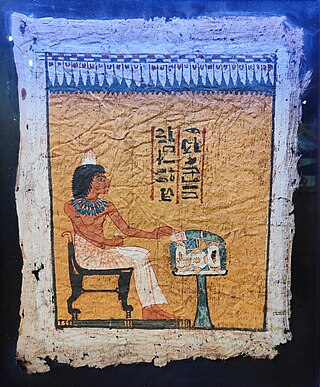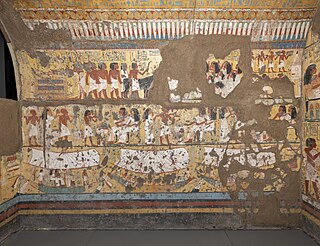
Ammit was an ancient Egyptian goddess with the forequarters of a lion, the hindquarters of a hippopotamus, and the head of a crocodile—the three largest "man-eating" animals known to ancient Egyptians. In ancient Egyptian religion, Ammit played an important role during the funerary ritual, the Judgment of the Dead.

Meretseger was a Theban cobra-goddess in ancient Egyptian religion, in charge with guarding and protecting the vast Theban Necropolis — on the west bank of the Nile, in front of Thebes — and especially the heavily guarded Valley of the Kings. Her cult was typical of the New Kingdom of Egypt.

Saqqara, also spelled Sakkara or Saccara in English, is an Egyptian village in the markaz (county) of Badrashin in the Giza Governorate, that contains ancient burial grounds of Egyptian royalty, serving as the necropolis for the ancient Egyptian capital, Memphis. Saqqara contains numerous pyramids, including the Pyramid of Djoser, sometimes referred to as the Step Tomb, and a number of mastaba tombs. Located some 30 km (19 mi) south of modern-day Cairo, Saqqara covers an area of around 7 by 1.5 km.

Deir el-Medina, or Dayr al-Madīnah, is an ancient Egyptian workmen's village which was home to the artisans who worked on the tombs in the Valley of the Kings during the 18th to 20th Dynasties of the New Kingdom of Egypt The settlement's ancient name was Setmaat, and the workmen who lived there were called "Servants in the Place of Truth". During the Christian era, the temple of Hathor was converted into a Monastery of Saint Isidorus the Martyr from which the Egyptian Arabic name Deir el-Medina is derived.

Senenmut was an 18th Dynasty ancient Egyptian architect and government official. His name translates literally as "mother's brother."

The ushabti was a funerary figurine used in ancient Egyptian funerary practices. The Egyptological term is derived from 𓅱𓈙𓃀𓏏𓏭𓀾 wšbtj, which replaced earlier 𓆷𓍯𓃀𓏏𓏭𓀾 šwbtj, perhaps the nisba of 𓈙𓍯𓃀𓆭 šwꜣb "Persea tree".

TT1 is the burial place of the ancient Egyptian official Sennedjem and members of his family in Deir el-Medina, on the west bank of the Nile opposite Luxor. The funerary complex consists of three pyramid-shaped chapels dedicated to, from south to north, Sennedjem's father or brother, Sennedjem himself, and to Sennedjem's son Khonsu. Of the three shafts associated with the chapels, only the shaft in front of Sennedjem's chapel was unrobbed. It led to a series of underground rooms, including the extensively decorated burial chamber.

The Theban Tomb TT33 is an ancient Egyptian tomb. Located in El-Assasif, it is part of the Theban Necropolis on the west bank of the Nile, opposite to Luxor. The tomb is the burial place of the ancient Egyptian Padiamenope, who was Prophet and Chief Lector Priest during the 26th Dynasty.

Theban Tomb TT2 is located in Deir el-Medina, part of the Theban Necropolis, on the west bank of the Nile, opposite to Luxor. It is the burial place of the ancient Egyptian official Khabekhnet and his family. Khabekhnet was Servant in the Place of Truth, during the reign of Ramesses II.
Khabekhnet was an Ancient Egyptian artisan. Khabekhnet lived in Deir el-Medina on the west bank of the Nile, opposite Thebes, during the reign of Ramesses II. He was a son of Sennedjem and Iyneferti, and was married to Sahti and probably Isis. He was buried in Tomb TT2 in the village necropolis.

The tomb of Kha and Merit, also known by its tomb number TT8, is the funerary chapel and burial place of the ancient Egyptian foreman Kha and his wife Merit, in the northern cemetery of the workmen's village of Deir el-Medina. Active during the mid-Eighteenth Dynasty, Kha supervised the workforce who constructed royal tombs in the reigns of pharaohs Amenhotep II, Thutmose IV and Amenhotep III. Of unknown background, he probably rose to this position through skill and was rewarded by at least one king. He and his wife Merit had three known children. Kha died in his 50s or 60s, while Merit died before him, seemingly unexpectedly, in her 30s.

The Theban Tomb TT10 is located in Deir el-Medina, part of the Theban Necropolis, on the west bank of the Nile, opposite Luxor. It is the burial place of the ancient Egyptian artisan named Penbuy, who lived during the 19th Dynasty. Penbuy shared his tomb with Kasa, also a Servant in the Place of Truth.

The Theban Tomb TT214 is located in Deir el-Medina, part of the Theban Necropolis, on the west bank of the Nile, opposite to Luxor.

Khawy was a guardian in the Place of Truth and servitor of Amun of Opet (Luxor) from the reign of Ramesses II. He lived in the workers village Deir el-Medina. Khawy is known from his tomb TT214, his house and several other inscriptions.
This page list topics related to ancient Egypt.

The Department of Egyptian Antiquities of the Louvre is a department of the Louvre that is responsible for artifacts from the Nile civilizations which date from 4,000 BC to the 4th century. The collection, comprising over 50,000 pieces, is among the world's largest, overviews Egyptian life spanning Ancient Egypt, the Middle Kingdom, the New Kingdom, Coptic art, and the Roman, Ptolemaic, and Byzantine periods.

"Khonsuemheb and the ghost", often known simply as A ghost story, is an ancient Egyptian ghost story dating back to the Ramesside period. Its protagonist is a priest named Khonsuemheb and the story revolves around his encounter with a restless ghost.

Sennefer was an Ancient Egyptian official with the title Servant in the Place of Truth at the end of the 18th Dynasty. He is mainly known due to his unlooted burial found in 1928 by excavations under Bernard Bruyère at Deir el-Medina. The burial chamber of Sennefer was found within the tomb of the servant at the place of truth Hormes. The small chamber contained the inscribed coffins of Sennefer and his wife Nefertiti. Both were found wrapped in linen. Sennefer was also adorned with a mummy mask. He had a heart scarab and was adorned with a pectoral. On his coffin was placed a painted piece of cloth, showing Sennefer before an offering table. Furthermore, the burial contained different types of furniture, including a bed, a box, a head rest and several pottery as well as stone vessels. The burial of a child in an undecorated box was found, too. Two shabti figures are datable by style to the end of the 18th Dynasty.

Bab el-Gasus, also known as the Priestly Cache and the Second Cache, was a cache of ancient 21st dynasty Egyptian mummies found at Deir el-Bahari in 1891. It was excavated by French Egyptologists Eugène Grebaut and Georges Daressy, with Urbain Bouriant and Ahmed Kamal, on the direction of Mohamed Ahmed Abd al‑Rassul, who had also revealed the location of the Royal Cache in 1881. The tomb entrance was located on the flat area just outside the precinct wall in front of the Mortuary Temple of Hatshepsut. The find was significant for Egyptology, particularly in respect of religion, mummification, and coffin studies. It is the largest intact tomb ever found in Egypt. Today, the contents of the tomb are spread between 30 museums worldwide.

TT338 is the burial place of the ancient Egyptian artist Maya and his wife Tamyt in Deir el-Medina near modern Luxor, Egypt. Maya was titled "outline-draughtsman of Amun" and was active in the late Eighteenth Dynasty. The chapel was probably discovered in the early 1900s. The painted interior depicts the funerary procession and feasts of the deceased; the decoration was detached by the discoverers and is housed today in the Museo Egizio in Turin, Italy.



















